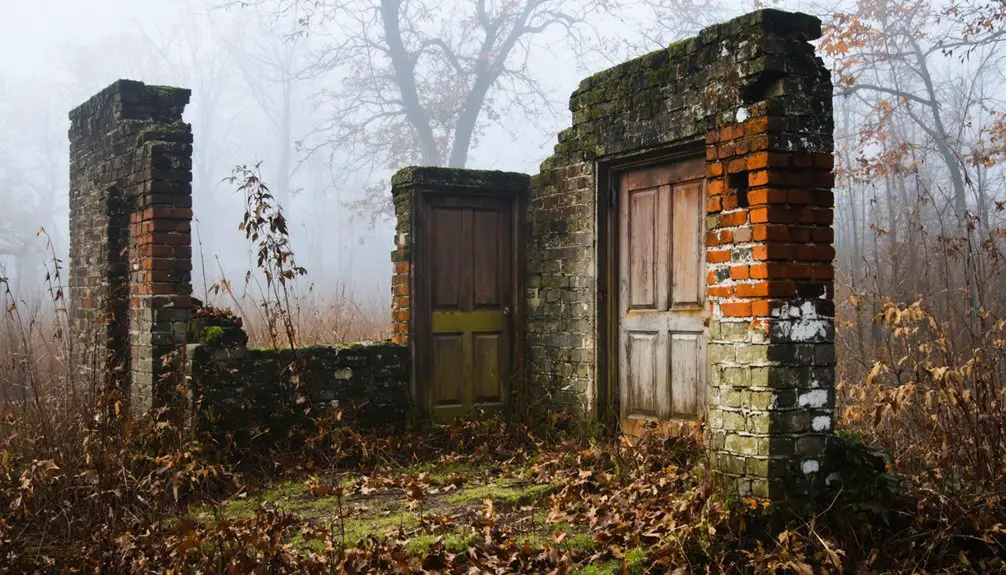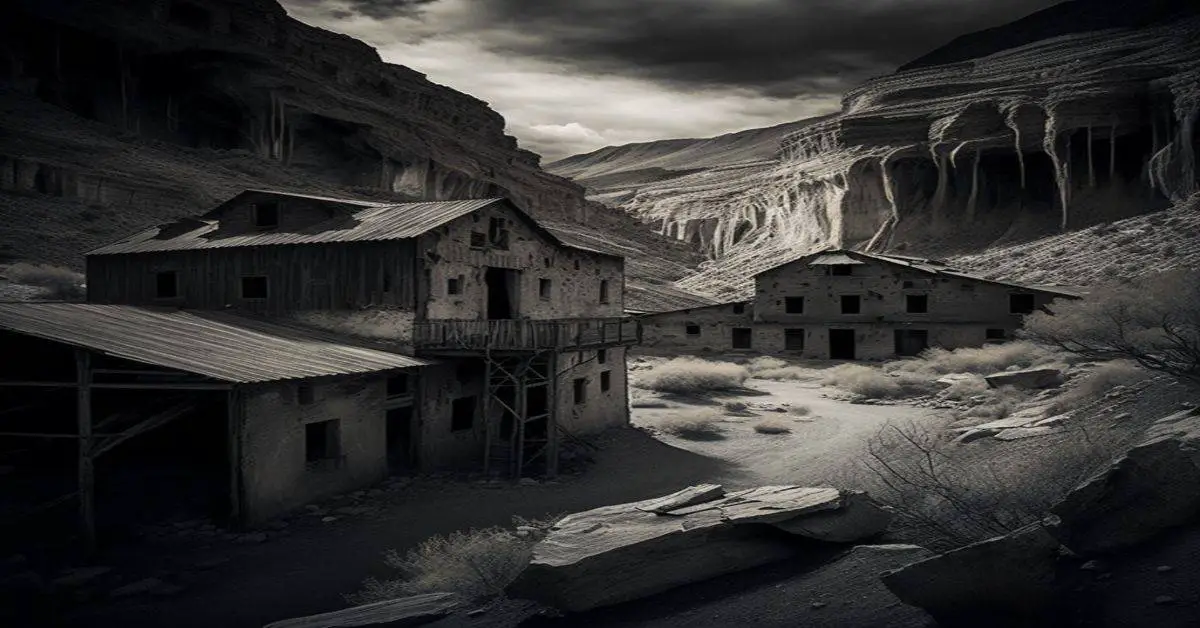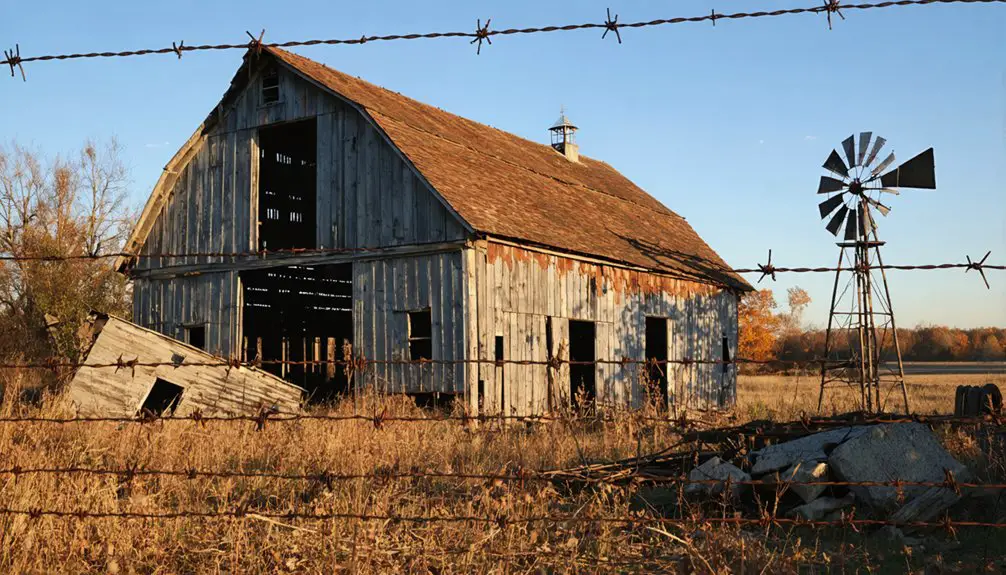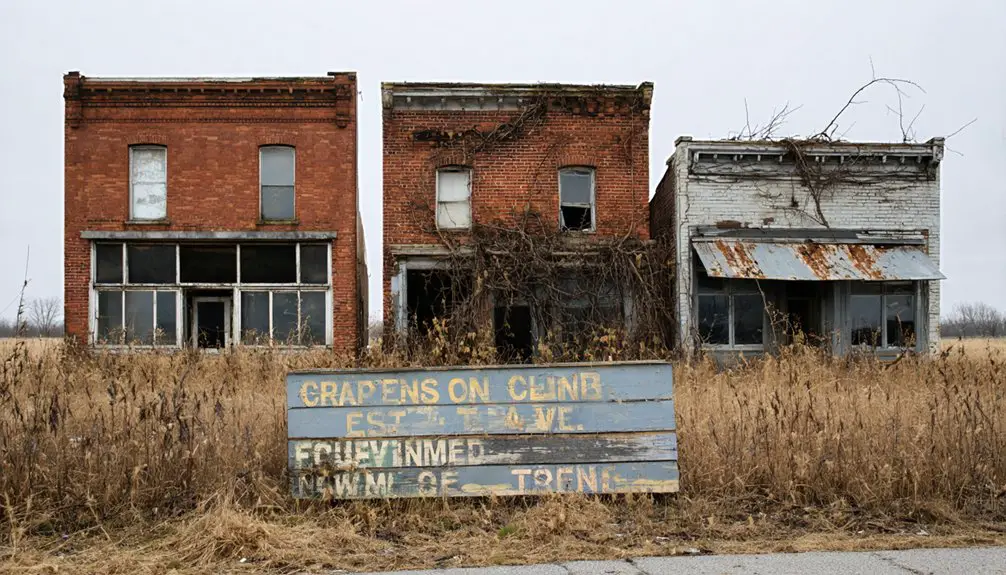You’ll find Newville’s fascinating history at the bottom of Pleasant Hill Lake in Ohio. Founded in 1823 by John Frederick Herring, this pioneer settlement thrived along the Clearfork River with its grist mills, taverns, and merchant shops. When the U.S. Army Corps of Engineers built a dam in the 1940s, residents were forced to evacuate their homes. While the town lies submerged today, its story of progress and sacrifice echoes through time.
Key Takeaways
- Newville, Ohio was established in 1823 along the Clearfork River but became a ghost town after flooding from Pleasant Hill Lake in 1936.
- The U.S. Army Corps of Engineers ordered mandatory evacuations in the 1940s, forcing residents to abandon their homes and properties.
- The original townsite now lies submerged beneath Pleasant Hill Lake, with only scattered foundations visible in surrounding forested areas.
- Lack of railroad access and transportation challenges contributed to Newville’s decline before its ultimate submersion.
- Some historic structures were relocated before flooding, while others like the stagecoach tavern disappeared beneath the lake waters.
Early Settlement and Town Origins
When John Frederick Herring platted Newville, Ohio in December 1823, he strategically chose a location at the confluence of Slater’s Run and the Clearfork of the Mohican River.
Having already established himself as a prominent mill operator in the area since 1811, Herring saw potential in this small valley surrounded by tree-covered hills. He’d named the settlement after his hometown of Newville, Pennsylvania. Since Newville was one of several locations sharing this name, the town became part of a larger geographical namesake network.
The pioneer lifestyle quickly took root as early settlers like Abraham Nye and Michael Hogan established essential services. Nye opened the town’s first tavern, creating a hub for community bonding, while Hogan became the first merchant. A gristmill was built by Herring before the town’s official founding, helping establish the area’s early industry.
Daniel Stoner’s blacksmith shop supported the growing settlement’s needs. The fertile valley, abundant water, and strategic location made it an ideal spot for these ambitious pioneers to build their new community.
Life Along the Clearfork River
Life along the Clearfork River shaped every aspect of Newville’s early development, as the 36.6-mile tributary provided essential resources for the fledgling settlement. The river ecology supported both survival and commerce, with fertile valley lands yielding bountiful crops while the water’s flow powered significant grist mills. The river’s path through Mohican State Park created a stunning natural backdrop for the community.
You’d have found a bustling pioneer lifestyle centered around the river, where John Frederick Herring’s mills drew settlers to the area. The river valley’s natural abundance attracted diverse community members – from tavern keepers to blacksmiths – while the waterway itself served as an important transportation route. McCluer’s dense fields of tall corn provided ideal cover for those seeking freedom.
At Sam McCluer’s riverside home, you might’ve witnessed the quiet courage of Underground Railroad activities, as the Clearfork’s winding path helped guide freedom seekers northward.
Economic Development and Commerce
Despite its eventual decline, Newville’s economic foundation began with a flourishing mix of essential businesses in the early 1800s.
You’d have found Michael Hogan’s merchant shop, Abraham Nye’s tavern, and Daniel Stoner’s blacksmith operation serving the growing community’s needs.
The town’s commercial significance centered on John Frederick Herring’s grist mill, built around 1811-12 on Clear Fork Creek.
When Francis Baughman took over in 1815, followed by John Hanawalt’s fifty-year operation, the mill became vital to the agricultural foundation of the region.
Newville was established in 1823 by settlers who recognized the area’s potential for commerce and industry.
Like many American towns facing economic struggles, the loss of industry and jobs led to widespread business closures and population decline.
However, you’ll find that Newville’s fortune changed dramatically when major railroads bypassed the town for Butler and Perrysville.
Without rail connections, the once-promising settlement couldn’t compete with neighboring communities, leading to its eventual abandonment during a flood control project.
Transportation Challenges and Isolation
Newville’s fate was largely sealed when major railroads bypassed the town in favor of stations in Butler and Perrysville, each roughly four miles away.
Similar to the abandoned railway lines in places like Moonville, the lack of transportation infrastructure ultimately contributed to the town’s decline.
You’ll find that this isolation from rail transport severely limited both passenger travel and the movement of goods, effectively cutting off Newville from larger markets during a critical period of 19th-century development.
The town’s limited road networks, complicated by seasonal flooding and poor maintenance, further compounded its transportation woes, making it increasingly difficult for residents to access the essential rail connections in neighboring communities.
The construction of a nearby dam in the 1940s ultimately led to the complete abandonment of Newville, marking the final chapter in its decline.
Railroad Bypass Impact
When railroad companies bypassed the small settlement of Newville in the 19th century, they inadvertently sealed the town’s fate. The lack of rail access proved devastating, as railroad influence shaped the economic landscape of 19th-century Ohio. The Big Four line connecting major cities like Cleveland, Columbus, and Cincinnati exemplified how vital rail connections were for community growth.
You’ll find that Newville’s isolation from major transportation networks triggered a swift economic decline, while neighboring towns with rail connections flourished. Similar to how Indiana Central Railway transformed Indianapolis’s connectivity in 1853, Newville’s lack of rail infrastructure left it disconnected from regional growth.
- Businesses and settlers chose rail-connected towns over Newville, leading to population shifts
- Higher transportation costs crippled local commerce and supply chains
- Loss of competitive advantage eliminated chances for county seat status
Without rail access, you couldn’t maintain essential connections to larger markets or participate in the region’s industrial growth.
The town’s entrepreneurs and craftsmen eventually left, seeking opportunities in better-connected communities, leaving Newville to fade into obscurity.
Limited Road Networks
The lack of rail service compounded with Newville’s primitive road networks to create a perfect storm of isolation.
You’ll find the town’s transportation history was marked by significant challenges, as early roads remained basic and poorly maintained, making year-round travel difficult. The absence of natural road corridors prevented the development of robust connections to major trade routes and nearby rail stations.
Road accessibility suffered further due to the Clear Fork River and Slaters Run’s seasonal flooding, which frequently damaged the limited infrastructure.
You’d have struggled to receive reliable goods, services, or emergency assistance through these primitive pathways. This restricted road network ultimately contributed to Newville’s decline, as residents faced mounting difficulties accessing essential services and economic opportunities, leading many to relocate to better-connected communities.
The Dam Project and Forced Exodus
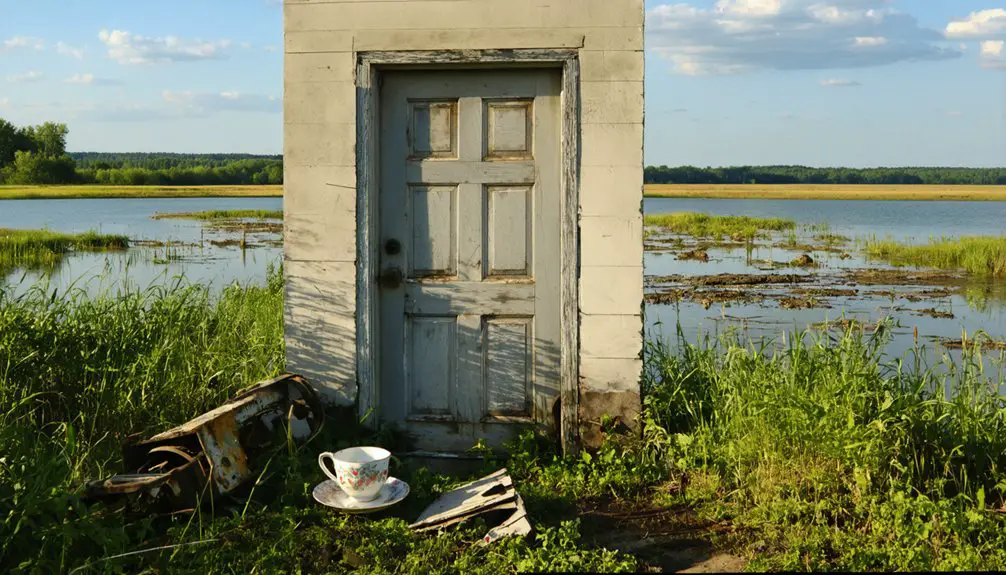
When the U.S. Army Corps of Engineers ordered Newville’s evacuation in the 1940s, residents were forced to abandon their homes and properties, often receiving contested or minimal compensation.
You’ll find that the dam’s construction and creation of Pleasant Hill Lake in 1936 dramatically transformed the local geography by impounding the Clearfork of the Mohican River.
Today, you can still spot old foundations and remnants of buildings in the forested areas west of Pleasant Hill Lake, where they stand as silent witnesses to the town’s forced exodus.
Corps Orders Evacuation Plans
During the early 1940s, U.S. Corps of Engineers initiated mandatory evacuation orders for Newville residents to make way for the Pleasant Hill Lake reservoir project.
You’ll find that evacuation logistics were strictly enforced, requiring all inhabitants to abandon their homes and properties within a tight timeline.
Here’s what you need to know about the Corps’ evacuation mandate:
- Resident compensation varied based on property size and individual investments, with some homeowners receiving less than others.
- The Corps conducted thorough land surveys and property assessments before issuing formal notices.
- While some houses were relocated entirely, most structures were demolished to clear the future floodplain.
You’ll see that this forced exodus permanently transformed the valley’s landscape, turning a once-thriving community into what would become a controlled waterbody zone under federal management.
Remnants After Dam Construction
Following completion of Pleasant Hill Dam in the 1940s, you’ll find that Newville’s physical remnants underwent dramatic transformation as rising waters submerged the original townsite.
While some remnant buildings were relocated through extensive logistical efforts, others were left to decay before the valley’s flooding. You can see how the historic stagecoach tavern and cherished watercress springs disappeared beneath Pleasant Hill Lake’s waters.
Today, the once-thriving settlement lies silent under the reservoir, its submerged history preserved only through local museums and historical markers.
The flooding reshaped not just structures but entire ecosystems, as farmlands gave way to an aquatic environment. The transformation turned former town grounds into recreational areas, though relocated structures still stand as tangible connections to Newville’s past.
Legacy in the Ohio Valley
Although Newville no longer exists as a physical town, its enduring impact on the Ohio Valley region can’t be understated.
You’ll find its cultural significance woven into the broader historical narratives of early Ohio settlement, representing a pivotal era when European migrants established communities following the Treaty of Greenville.
- The town’s story preserves the memory of early Ohio farming, milling, and small-town life that shaped the region’s development.
- The relocated Newville Church stands as a symbol of the community’s resilience and determination to preserve their heritage.
- Newville’s transformation due to flood control projects exemplifies how infrastructure development reshaped many American communities.
The town’s legacy lives on through archaeological remains near Pleasant Hill Lake, reminding you of the sacrifices made for modern progress.
Frequently Asked Questions
Are There Any Paranormal Activities Reported in the Abandoned Town Ruins?
You won’t find documented ghost sightings or eerie sounds in these ruins. Unlike other haunted ghost towns, there aren’t any confirmed paranormal activities or supernatural encounters reported here.
Can Visitors Access the Original Town Site Near Pleasant Hill Lake Today?
While you can reach the town’s remnants near Pleasant Hill Lake, there aren’t established visitor guidelines. You’ll find foundations and ruins in the forested area, but you’re exploring at your own risk.
What Happened to the Displaced Residents After Leaving Their Homes?
You’ll find the displaced residents scattered to nearby growing towns, facing resettlement challenges as they integrated into new communities. Some maintained connections through informal community reunions over subsequent decades.
Did Any Original Newville Buildings Survive and Get Relocated Successfully?
Like a lone survivor standing tall, the 1911 Newville Church is the only original structure you’ll find today, successfully relocated to O’Possum Run Road’s intersection while other historical buildings were lost forever.
Were There Any Notable Crimes or Significant Events During Newville’s Active Years?
You won’t find any documented crime history in the records. The most significant events were recurring floods and the 1940s flood control project that ultimately led to the town’s evacuation.
References
- https://thebargainhunter.com/news/features/a-series-of-ill-suited-circumstances-leads-to-one-of-ohio-s-ghost-towns
- https://ohioghosttowns.org/richland-county/
- https://kids.kiddle.co/Newville
- https://en.wikipedia.org/wiki/Newville
- https://en.wikipedia.org/wiki/Hell_Town
- https://richland.ohgenweb.org/Hist-Newville1903.htm
- https://richlandcountyhistory.com/2019/08/01/legends-of-the-clear-fork-sam-mccluer-and-his-cornfield/
- https://en.wikipedia.org/wiki/Clear_Fork_Mohican_River
- https://richlandcountyhistory.com/2019/06/04/the-end-of-the-world-in-newville-1844/
- https://www.youtube.com/watch?v=inRD6vYBy8M
